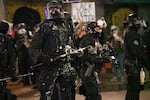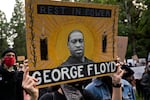The city of Portland will pay $375,000 to a woman who claims a flashbang grenade launched by police during a 2020 protest sent shrapnel into her body, gave her a concussion and caused long-term mental and physical stress.
The settlement is the latest among dozens of legal deals the city has reached with protesters who joined widespread demonstrations for racial justice and against police brutality in 2020, following the killing of George Floyd by a Minneapolis police officer.

Protesters returned to the Justice Center on day 76 of protests against systemic racism and police violence.
Jonathan Levinson / Jonathan Levinson
The Portland City Council unanimously approved the settlement.
According to court filings, Meghan Opbroek regularly attended demonstrations in the city that summer. She had attended a protest on June 25, 2020, in downtown Portland and then relocated to a protest near the Portland Police Bureau’s North Precinct shortly after 1 a.m. on June 26.
Opbroek stood near the intersection of Northeast Martin Luther King Jr. Boulevard and Northeast Emerson Street, court records said. She chanted and filmed with her cell phone until officers declared the demonstration an unlawful assembly. Opbroek said she turned away from the North Precinct building to comply with police. As she was leaving, she said, an officer fired a flashbang that “exploded on or near Opbroek, seriously injuring her.”
Her complaint includes graphic photos of shrapnel wounds in her legs, burns and extensive bruises on her body. Opbroek detailed her injuries to city councilors as they considered the lawsuit settlement last week:
“I was unable to hear anything. All I could see was stars. It blew my phone out of my hand, and I was only able to make it about a quarter-block before I couldn’t walk anymore,” Opbroek said. “The force of the blast would kill so much flesh that I eventually had to have debridements, where (medical staff) take a scalpel and cut away the dead tissue.”
Opbroek said the injuries, as well as a concussion, kept her out of work.
A flashbang grenade is a type of explosive designed to disorient crowds of people. They can contain gas or other elements. Opbroek identified in court records that the one at her feet contained rubber balls, which are referred to as Rubber Ball District Devices — or RBDDs.

A crowd assembles near Revolution Hall in Southeast Portland, Ore., to protest police brutality Tuesday, June 2, 2020. It marked the fifth consecutive night of demonstrations in Portland brought on by the killing of George Floyd by a white police officer in Minnesota.
Eric Slade / OPB
A city attorney said Portland no longer uses RBDDs. An inventory report from April 15, 2025, shows the bureau still stocks other kinds of crowd dispersal grenades, such as an aerosol grenade that irritates the skin and eyes. But there are no RBDDs listed in the report.
Flashbangs have drawn headlines in the past for burning and injuring protesters. The city of Portland agreed to pay $125,000 to a man who suffered a traumatic brain injury after a police-fired flashbang grenade hit him in the head in August 2018.
A 2015 ProPublica investigation found that police departments have relied less and less on the devices because of the damage they can inflict.
The city attorney’s office and the Portland Police Bureau both recommended agreeing to the settlement, a deputy city attorney said during the council meeting.
Prior to the vote, Councilor Sameer Kanal asked Commander Craig Dobson what steps the bureau has taken to change how it handles large protests. Dobson noted the bureau has rewritten its policies and now uses so-called “dialog officers” to talk with organizers and use more “intelligence-led” tactics.
Dobson credited those shifts for helping keep recent protests, including the large May Day protests throughout Portland earlier this month, comparatively peaceful.
“I think in the past several months you’ve seen a different style of policing from us when it comes to public order events,” Dobson said.
The city of Portland has paid more than $4.5 million in the past five years to settle claims linked to the city police force. Most of those payments went to people injured during the 2020 protests.

Protesters gathered at Laurelhurst Park before marching to the Multnomah County Sheriff's Office in Southeast Portland on the third night of largely peaceful protests on May 31, 2020.
Jonathan Levinson / Jonathan Levinson